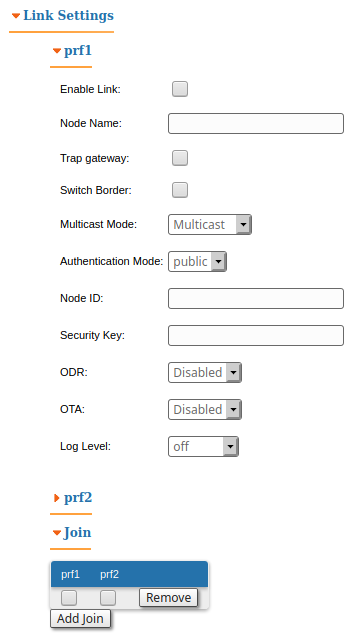

In the "Link Settings" section you can configure the parameters for the pseudo radio interface and for the Join function.
prf
In the "prf" subsection, you can configure thepseudo radio link as a MINT network node. The "prf" subsection is available for configurations only after at least one pseudo radio interface has been created in "Network Settings" section. Pseudo radio interface is used to provide MINT-over-Ethernet.
| Parameter | Description |
|---|
| Enable link | | | Node Name | - Set the name for this node in the network
- This node name will appear on the neighbor lists
| | Trap gateway | - Enable/disable gateway for SNMP traps
| | Switch border | - Enable/disable the switch border mode. In this mode the unit operates as a "borderline" between the MINT domains, i.e. prevents the distribution of information about the switch groups and data transfer between these domains, while retaining all the capabilities of the MINT protocol (obtaining information about the whole MINT network, sending remote commands etc.)
| Multicast Mode (Master) | - Traffic transmission mode:
- "Multicast" - conventional mode that uses modulation one step lower than the lowest modulation among the traffic receivers when transmitting the "multicast/broadcast" frames. In the case of "multicast" streams information from "IGMP Snooping" module is used to obtain a list of subscribers. Consequently, the list of all connected sector clients is used for the "broadcast" traffic.
- Transformation of "Multicast" to "Unicast". In case two or more clients are assigned to the same "multicast" stream a copy of source stream will be sent to each of them in the "Unicast" mode.
- "Unicast 2", "Unicast 3", "Unicast 4", "Unicast 5" - the number of subscribers limitation. Conventional "Multicast" mode will be used when the number is exceeded.
- "Unicast All" - transformation is always executed.
Transformation to "Unicast" requires memory data copying that increases CPU load. Besides, the use of "Unicast" streams increases the volume of transmitted traffic proportional to the number of subscribers and reduces the sector available throughput. "Unicast 3" mode is set by default. |
Transformation of "Multicast" to "Unicast" via CLI is described in the section "mint command". |
| | Authentication Mode | - Set the mode:
- "static" - the unit can establish connections only with units, which MAC-addresses are listed in the "Static Links" section
- public - the unit can establish connections with any other units which have the same security key and the corresponding wireless connection settings
- "remote" - centralized authentication mode with remote server (e.g. RADIUS or relay). In this mode any node can request the information from a remote authentication server (remote authentication server parameters are set using “AAA” command). This means that the node must have an access to this server (e.g. using IP)
| | ODR | Activate routing using the ODR protocol. The following modes are available: - "Disable" - routing using ODR is not performed.
- "Hub" - the device acts as a central node.
- "Spoke" - the device acts as a peripheral node.
The main advantage of ODR protocol is a network throughput efficient use. Part of the link throughput is usually used by the routing protocol to transmit service information, this part can be released by ODR using. The ODR protocol transmits the hosts IP prefixes using the MINT protocol at the data link layer. The ODR protocol can only be used in networks with star topology, where all nodes are connected to the central node only. An example of such a network is a point-to-multipoint topology, where each subscriber is connected only to a base station. | | OTA | Automatic updates in the MINT domain may be configured in the following modes: - “Disabled” - the device does not check if other devices in the MINT domain have a newer software versions.
- "Passive" - in case a newer software version is detected on one of the neighboring nodes, the device requests and updates the software. The device does not announce own software version.
- "Active" - the device announces its software version in the MINT domain, making it available to download by other nodes.
| | Log Level | | | Node ID | - Set the device identification number
- The parameter is optional
- Node ID can be configured by the administrator for a better representation of a neighbors table (nodes within a wireless network)
| | Security Key | - Set the secret key word for encoding of the protocol messages
- It must be up to 64 characters long, without spaces
- It must be the same at both ends of the link
|
|
|
Join
In the "Join" subsection, you can link two or more pseudo-radio interfaces of one unit into one MINT domain. Each of these interfaces may act as an independent MINT network node. The "Join" subsection is available for configurations only after at least one pseudo-radio interface has been created in "Network Settings" section. In order to join the interfaces, simply enable the check boxes of the corresponding interfaces.
